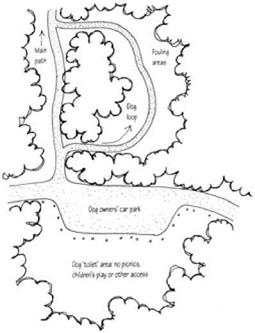Many people, particularly in densely populated areas, walk on a daily basis to exercise their dogs. This means that paths can be fouled by dog mess, presenting a hazard underfoot and a risk to health, particularly for children. Hence it is important to plan for dog walking from the outset, or redesign the trail system if it is currently a problem.
One method of coping with dogs is to devise special loops along which people can be encouraged to take their dogs when they first enter the recreation area. This enables dogs to do their business before a longer walk along the main paths commences.
The second method, more appropriate at car parks, is to set aside an area for dogs to use—a ‘dogs’ toilet’. It should be clearly marked in order to let dog owners know that it is for their dogs to use, and to prevent other people from inadvertently walking over it. The area needs to be large enough so that dog mess decays before too much build-up occurs.
The other device is to insist that dog owners collect and dispose of their dogs’ mess. This is more common and easier to implement in urban parks than in remoter locations.
|
This diagram shows a couple of ways in which the problem of dog fouling can be reduced at a car park and trail area. |
Dogs can also cause a nuisance by disturbing livestock, wildlife or other dog owners. Management strategies may range from insisting that all dogs are under control at all times (preferably on a leash) to banning dogs in some areas at particular times of year, such as lambing or nesting seasons.




